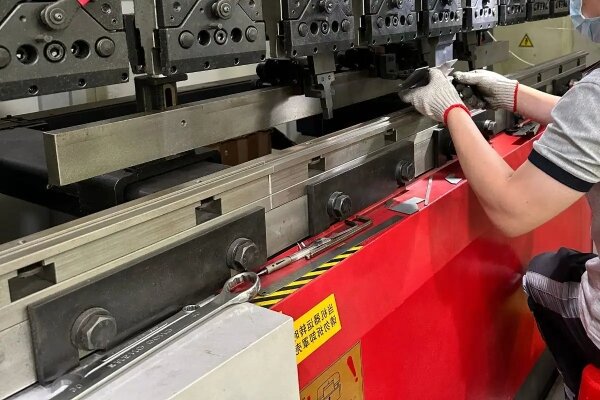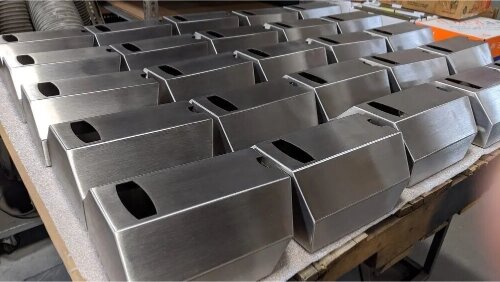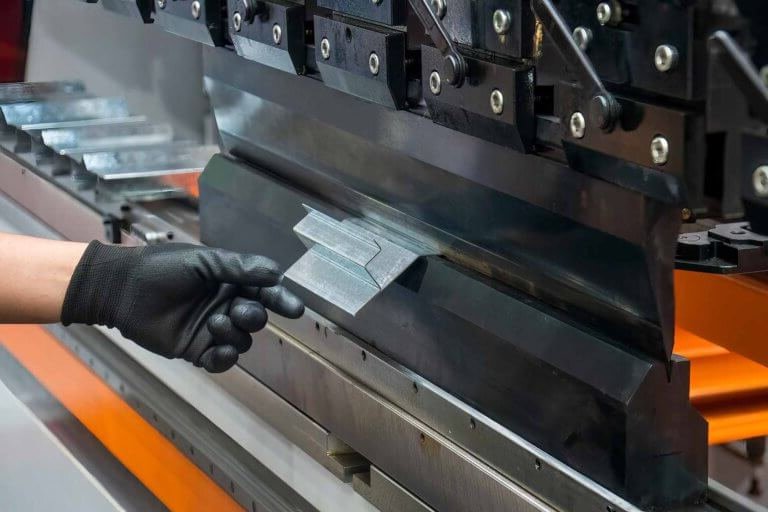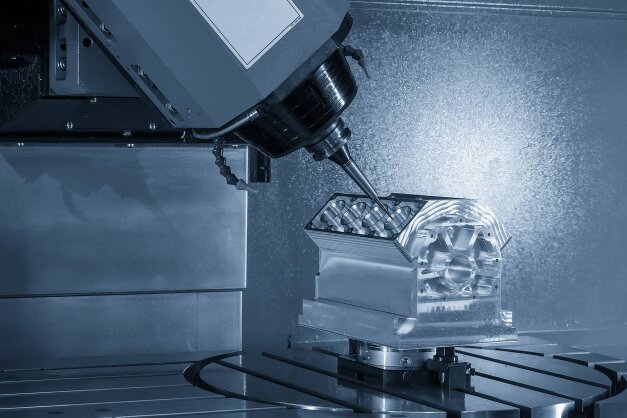다음 프로젝트를 위해 CNC 커팅과 레이저 커팅 중 어떤 것을 선택해야 할까요? CNC 커팅과 레이저 커팅은 모두 고유한 이점을 제공하지만 용도가 다릅니다. 어떤 것이 여러분의 필요에 맞는지 결정할 수 있도록 세분화해 보겠습니다.
CNC는 물리적 절단 도구를 사용하여 직접 접촉을 통해 재료를 제거하므로 두꺼운 재료와 3D 모양에 이상적입니다. 레이저 커팅은 집중된 광선을 사용하여 접촉 없이 재료를 녹이거나 태우거나 기화시켜 얇고 중간 정도의 재료에 높은 정밀도를 제공합니다.
특정 프로젝트에 어떤 커팅 방법이 가장 적합한지 알고 싶으신가요? 올바른 선택을 하는 데 도움이 되는 주요 차이점을 살펴보세요.
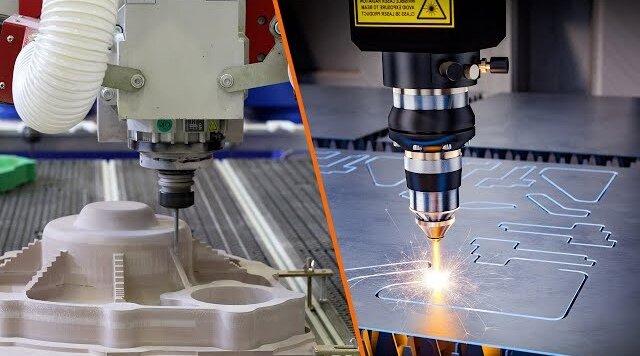
CNC 커팅이란 무엇인가요?
CNC 절단은 컴퓨터로 제어되는 기계와 물리적 절단 도구를 사용하여 재료를 제거합니다. 기계는 프로그래밍된 경로를 따라 원하는 모양과 특징을 만듭니다.
이 프로세스는 CAD 소프트웨어를 사용하여 생성되는 디지털 디자인으로 시작됩니다. 그런 다음 설계는 CNC 기계가 이해할 수 있는 G코드 언어로 변환됩니다. 기계는 이 코드를 읽고 그에 따라 절삭 공구를 움직입니다.
일반적인 CNC 절단기 유형
CNC 절단기에는 여러 가지 유형이 있으며, 각각 다른 작업에 적합합니다:
- CNC 밀링 머신: 회전 도구를 사용하여 재료를 제거합니다. 여러 방향으로 자를 수 있으며 3D 모양을 만드는 데 유용합니다.
- CNC 선반 고정된 절삭 공구가 재료를 회전시키면서 모양을 만듭니다. 원통형 부품에 적합합니다.
- CNC 플라즈마 절단기: 플라즈마 토치를 사용하여 강철과 같은 전기 전도성 재료를 절단합니다. 속도가 빠르며 두꺼운 금속판에도 잘 작동합니다.
- CNC 라우터 밀링 머신과 비슷하지만 목재나 플라스틱과 같은 부드러운 소재에 자주 사용됩니다. 목공이나 간판 제작에 흔히 사용됩니다.
CNC 커팅은 어떻게 작동합니까?
CNC 절단은 단계별 프로세스를 따릅니다:
- 디자인 창조: 디자이너가 CAD 소프트웨어를 사용하여 3D 모델을 만듭니다.
- 코드 생성: 디자인이 CNC 기계가 읽을 수 있는 G-코드로 변환됩니다.
- 기계 설정: 작업자가 재료를 로드하고 적절한 절삭 공구를 선택합니다.
- 절단 공정: 기계가 G코드 지침에 따라 재료를 절단합니다. 도구는 여러 축(일반적으로 3~5개)을 따라 이동하여 원하는 모양을 만듭니다.
- 마무리 손질: 절단 후 부품에 샌딩 또는 연마와 같은 추가 마감이 필요할 수 있습니다.
CNC 커팅의 장점
- 다재: CNC 절단은 금속, 목재, 플라스틱, 복합재 등 다양한 재료로 작업할 수 있습니다.
- 정도: CNC 기계는 높은 정확도를 제공하므로 복잡한 설계와 엄격한 공차에 이상적입니다.
- 3D 기능: CNC 커팅은 3D 모양과 복잡한 형상을 만들 수 있습니다. 깊이와 디테일이 필요한 프로젝트에 적합합니다.
- 내구성: CNC 기계는 견고하며 고강도 작업을 처리할 수 있습니다. 오래 사용할 수 있도록 제작되어 오랜 기간 문제 없이 작동할 수 있습니다.
- 맞춤화: CNC 커팅으로 쉽게 사용자 정의할 수 있습니다. 특정 프로젝트 요구 사항을 충족하도록 디자인을 빠르게 전환하고 설정을 조정할 수 있습니다.
CNC 커팅의 단점
- 비용: CNC 기계는 초기 비용과 운영 비용이 높습니다. 공구가 마모되어 정기적으로 교체해야 하므로 비용이 추가됩니다.
- 속도: CNC 절단은 특히 두꺼운 재료의 경우 레이저 절단보다 느립니다. 이 공정에는 여러 단계가 포함되므로 생산 시간이 늘어날 수 있습니다.
- 복잡한 설정: CNC 기계를 설정하는 데는 시간이 많이 걸릴 수 있습니다. 기계를 프로그래밍하고 공구를 조정하려면 숙련된 작업자가 필요합니다.
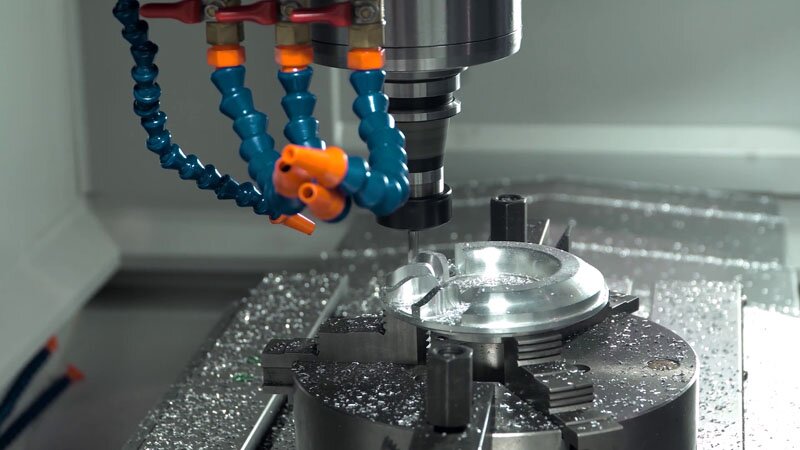
레이저 절단이란 무엇입니까?
레이저 절단 는 집중된 레이저 빔을 사용하는 고정밀 재료 절단 방식입니다. 레이저는 미리 정해진 경로를 따라 재료를 녹이거나 태우거나 기화시킵니다. 이 비접촉 방식은 다양한 재료 유형에 걸쳐 복잡한 디자인과 깔끔한 가장자리를 만들 수 있습니다.
레이저 빔은 거울을 통해 재료 표면으로 향하고 렌즈를 통해 재료 표면에 초점을 맞춥니다. 집중된 열은 빔이 프로그래밍된 경로를 따라 이동하면서 깔끔한 커팅을 생성합니다. 컴퓨터 제어가 높은 정밀도를 보장합니다.
레이저 커팅 기술의 종류
레이저 커팅 기술에는 다음과 같은 여러 유형이 있습니다:
- CO2 레이저: 이 레이저는 두꺼운 금속, 목재 및 아크릴 소재를 절단하는 데 표준으로 사용됩니다. 높은 출력을 제공하며 섬세한 절단에 탁월합니다.
- 파이버 레이저: 파이버 레이저는 더 효율적이고 정밀도가 높아 스테인리스 스틸 및 알루미늄과 같은 금속을 절단하는 데 이상적입니다. 집중된 빔이 더 작기 때문에 더 날카롭게 절단할 수 있습니다.
- Nd: YAG 레이저: 이 레이저는 일반적으로 금속 절단 및 정밀 조각에 사용됩니다. 가격이 비쌀 수 있지만 특정 용도에 매우 효과적입니다.
레이저 커팅은 어떻게 작동하나요?
레이저 커팅은 디자인을 완제품으로 변환하는 여러 단계를 거칩니다:
- 디자인 창조: 디자이너는 CAD 소프트웨어를 사용하여 디지털 파일을 만듭니다. 이 파일은 컷의 모양과 치수를 정의합니다.
- 기계 설정: 작업자가 레이저 커팅기에 재료를 로드하고 적절한 설정(예: 레이저 출력, 속도, 초점)을 선택합니다.
- 레이저 커팅 프로세스: 레이저 빔이 재료의 표면으로 향합니다. 빔은 디자인 경로를 따라 이동하면서 재료를 녹이거나 기화시킵니다. 보조 가스(질소 또는 산소 등)는 종종 이물질을 날려버리고 절단 품질을 개선하는 데 사용됩니다.
- 마무리 손질: 절단 후 가장자리는 일반적으로 매끄럽고 추가 마감이 거의 필요하지 않습니다.
레이저 절단의 장점
- 높은 정밀도: 레이저 커팅은 종종 밀리미터 단위의 탁월한 정확도를 제공합니다.
- 속도: 레이저 커팅은 특히 얇은 소재의 경우 빠릅니다.
- 가장자리 정리: 이 프로세스는 최소한의 버로 부드럽고 깨끗한 가장자리를 생성합니다.
- 낮은 유지보수: 레이저 커팅기는 CNC 기계에 비해 유지보수가 덜 필요합니다.
레이저 커팅의 단점
- 재료 두께 제한: 레이저 커팅은 두꺼운 재료에 어려움을 겪습니다. 빔이 더 깊숙이 침투할수록 출력이 손실되어 절단이 고르지 않게 됩니다.
- 반사 소재: 구리나 황동과 같이 반사율이 높은 소재는 절단하기 어려울 수 있습니다. 레이저 빔이 반사되어 기계가 손상될 수 있습니다.
- 열 영향 구역: 레이저는 열을 발생시켜 절단된 가장자리 근처의 재료 특성을 변경할 수 있습니다.
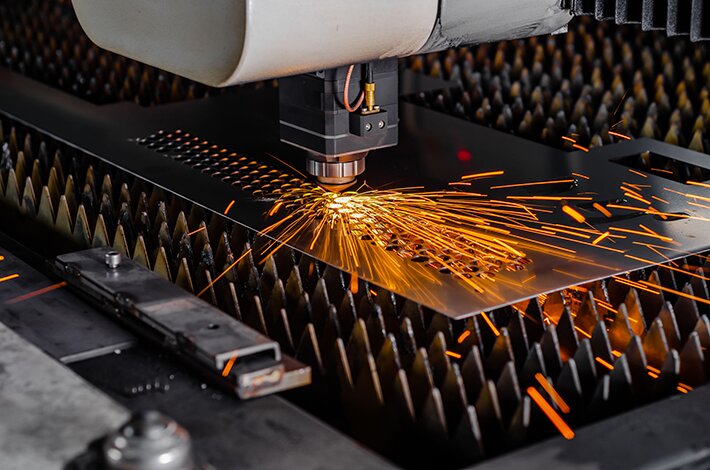
CNC 커팅과 레이저 커팅: 주요 차이점
CNC와 레이저 커팅은 다양한 제조 요구사항에 따라 뚜렷한 이점을 제공합니다. 차이점을 이해하면 프로젝트에 적합한 프로세스를 선택하는 데 도움이 됩니다.
정밀도와 정확성
CNC 절단은 일반적으로 ±0.001~±0.005인치의 공차로 우수한 정밀도를 달성합니다. 계단식 컷, 베벨, 가변 깊이 컷과 같은 3D 피처를 만드는 데 탁월합니다.
레이저 커팅은 얇은 재료에 대해 ±0.0005인치의 엄격한 공차로 탁월한 정밀도를 제공합니다. 물리적 절단 도구로는 불가능한 복잡한 패턴과 작은 디테일을 절단할 수 있습니다.
절단 속도 비교
레이저 커팅은 얇은 소재의 경우 훨씬 빠릅니다. 그러나 재료 두께가 증가하면 레이저 절단 속도가 상당히 느려집니다.
CNC 절단은 다양한 재료 두께에 걸쳐 보다 일관된 속도를 유지합니다. 얇은 재료의 경우 속도가 느리지만, 두께가 1/2인치 이상인 재료의 경우 CNC 절단이 레이저 절단보다 더 효율적입니다.
재료 호환성
레이저 커팅은 판금, 아크릴, 목재, 직물과 같이 얇고 평평한 소재에 가장 적합합니다. 구리나 황동과 같이 두꺼운 소재나 반사율이 높은 표면에는 어려움을 겪습니다.
CNC 절단은 두꺼운 금속, 목재, 플라스틱, 복합재 등 다양한 재료를 다룰 수 있습니다. 3D 모양과 더 단단한 재료에 더 다양하게 활용할 수 있습니다.
두께 제한 및 재료 유형
레이저 커팅은 재료 두께에 따라 제한됩니다. 레이저의 종류에 따라 최대 약 20mm 두께의 재료에 적합합니다. 재료가 두꺼울수록 더 많은 출력이 필요하고 절단이 고르지 않을 수 있습니다.
CNC 절단은 최대 몇 인치까지 훨씬 두꺼운 재료를 처리할 수 있습니다. 레이저 커팅이 어려운 고강도 작업에 더 적합합니다. 많은 CNC 작업에는 두께에 대한 상한선이 거의 없습니다.
에너지 효율성 및 비용 고려 사항
레이저 커팅기는 초기 비용은 높지만 운영 비용은 낮습니다. 얇은 재료에 에너지를 적게 사용하고 유지보수를 최소화할 수 있지만 재료 두께에 따라 비용이 증가합니다.
CNC 기계는 공구 마모와 높은 에너지 소비로 인해 더 비쌉니다. 속도보다 다용도성과 재료 두께가 더 중요한 프로젝트에 더 적합합니다.
환경 적 영향
레이저 커팅은 재료를 덩어리로 제거하는 대신 기화시켜 폐기물을 덜 발생시킵니다. 하지만 플라스틱이나 코팅된 금속을 절단할 때 연기와 가스를 많이 배출할 수 있습니다.
CNC 절단은 칩과 부스러기 형태의 폐기물을 더 많이 생성합니다. 이 폐기물은 종종 재활용할 수 있지만 레이저 절단보다 공정이 덜 깨끗합니다.
CNC와 레이저 커팅 중 선택할 때 고려해야 할 요소
CNC와 레이저 커팅 중 하나를 선택하는 것은 여러 가지 요인에 따라 달라집니다. 프로젝트에 가장 적합한 결정을 내리는 데 도움이 되는 주요 고려 사항을 살펴보세요.
프로젝트 규모 및 복잡성
CNC 절단은 더 광범위하고 복잡한 프로젝트에 더 적합합니다. 여러 절단 각도가 필요한 3D 모양과 복잡한 디자인을 처리할 수 있습니다. 프로젝트에 다음이 포함되는 경우 CNC를 사용하는 것이 좋습니다. 교련, 밀링 또는 인그레이빙.
레이저 커팅은 섬세한 디테일이 있는 작고 평평한 프로젝트에 이상적입니다. 높은 정밀도가 필요한 복잡한 패턴과 디자인에 적합합니다. 그러나 3D 모양이나 무거운 작업에는 적합하지 않습니다.
재료 및 두께 요구 사항
CNC 절단은 두꺼운 금속, 목재, 플라스틱 등 다양한 재료로 작업할 수 있습니다. 다목적이며 몇 인치 두께의 재료도 처리할 수 있습니다. 프로젝트에 무겁거나 까다로운 재료가 포함되는 경우 CNC가 더 나은 선택입니다.
레이저 커팅은 판금, 아크릴, 직물과 같은 얇은 소재에 가장 적합합니다. 두꺼운 재료와 반사율이 높은 표면에서는 어려움을 겪습니다. 얇고 평평한 재료의 경우 레이저 커팅은 뛰어난 정밀도와 속도를 제공합니다.
소규모 및 대규모 생산 실행을 위한 비용 효율성
CNC 절단은 중소규모 생산에 비용 효율적입니다. 설치 비용은 더 높지만 다목적이며 다양한 작업을 처리할 수 있습니다. 대량 생산 시에는 단위당 가격이 낮아져 더욱 경제적입니다.
레이저 커팅은 특히 얇은 소재의 경우 대량 생산에 더 비용 효율적입니다. 초기 설정과 공정이 더 빨라 인건비를 절감할 수 있습니다. 설정 시간으로 인해 소규모 생산의 경우 단위당 비용이 더 높을 수 있습니다.
리드 타임 및 처리 시간
특히 복잡한 디자인과 두꺼운 소재의 경우 CNC 절단은 시간이 더 오래 걸립니다. 이 프로세스에는 공구 교체 및 재료 제거와 같은 더 많은 단계가 포함되므로 리드 타임이 늘어날 수 있습니다.
특히 얇은 소재의 경우 레이저 커팅이 더 빠릅니다. 프로세스가 간소화되고 공구를 교체할 필요가 없어 마감 기한이 촉박한 프로젝트에 이상적입니다.
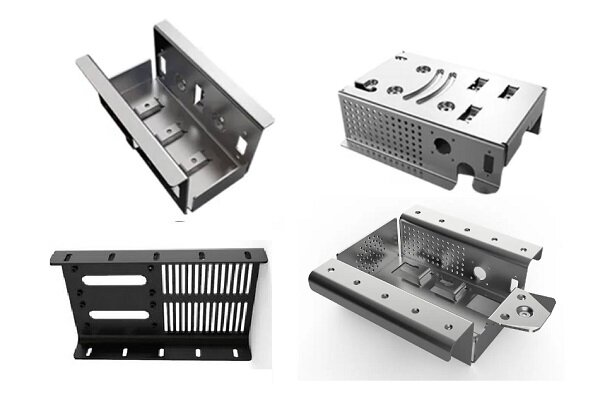
CNC 커팅은 언제 선택해야 하나요?
CNC 절단은 다재다능하고 견고한 방법이지만 모든 프로젝트에 항상 최선의 선택은 아닙니다. CNC 절단이 빛을 발하는 특정 애플리케이션을 살펴보겠습니다.
- 항공우주 부품: CNC 절단은 항공기 및 우주선을 위한 정밀 부품을 제작합니다. 이 산업에서 요구되는 견고한 재료와 복잡한 형상을 처리할 수 있습니다.
- 자동차 부품: CNC 절단은 엔진 부품에서 맞춤형 자동차 부품에 이르기까지 자동차 산업에서 널리 사용됩니다. 내구성이 뛰어난 고정밀 부품을 제작하는 데 적합합니다.
- 프로토타이핑: CNC 커팅은 프로토타입 제작에 이상적입니다. 이를 통해 디자이너는 대량 생산으로 전환하기 전에 디자인을 테스트하고 개선할 수 있습니다.
- 금속 제조: CNC 절단은 일반적으로 브래킷, 프레임 및 기타 구조 구성 요소를 만들기 위해 금속 제작에 사용됩니다. 무거운 작업에 적합합니다.
- 목공: CNC 커팅은 가구, 캐비닛 및 장식용 조각을 만드는 데 널리 사용됩니다. 복잡한 디자인과 큰 조각을 쉽게 처리할 수 있습니다.
레이저 커팅은 언제 선택해야 하나요?
레이저 커팅은 정밀하고 효율적이지만 모든 프로젝트에 항상 최선의 선택은 아닙니다. 레이저 커팅이 빛을 발하는 특정 응용 분야를 살펴보겠습니다.
- 전자제품: 레이저 커팅은 회로 기판 및 인클로저와 같은 전자 부품을 정밀하게 제작합니다. 작고 섬세한 부품에 적합합니다.
- 간판 및 장식: 레이저 커팅은 간판, 장식 패널 및 예술적 디자인을 만드는 데 널리 사용됩니다. 복잡한 패턴과 미세한 디테일을 쉽게 처리할 수 있습니다.
- 의료 기기: 의료 산업에서는 레이저 커팅을 사용하여 스텐트 및 수술 기구와 같은 장치의 정밀한 부품을 제작합니다. 고정밀 작업에 이상적입니다.
- 패션 및 섬유: 레이저 커팅은 패션 산업에서 직물과 가죽에 복잡한 패턴을 만드는 데 사용됩니다. 맞춤형 디자인 및 소량 생산에 적합합니다.
- 프로토타이핑: 레이저 커팅은 프로토타입, 특히 평면 부품을 제작하는 데 이상적입니다. 이를 통해 디자이너는 대량 생산으로 전환하기 전에 디자인을 빠르게 테스트하고 개선할 수 있습니다.
결론
CNC와 레이저 커팅은 프로젝트의 필요에 따라 고유한 이점을 제공합니다. CNC 절단은 두꺼운 재료, 크거나 복잡한 부품, 다양한 용도에 이상적입니다. 레이저 커팅은 정밀도, 속도, 효율성이 뛰어나며 특히 더 얇은 소재와 섬세한 디자인에 적합합니다. 재료 유형, 프로젝트 규모, 예산에 따라 CNC와 레이저 커팅 중 어떤 것을 선택할지 결정합니다.
프로젝트에 어떤 방법이 적합한지 잘 모르거나 다음 제조 실행에 대한 상담이 필요한 경우, 지금 바로 문의하세요. 프로세스를 안내하고 요구 사항을 충족하는 맞춤형 솔루션을 제공할 수 있습니다!
안녕하세요, 저는 케빈 리입니다

지난 10년 동안 저는 다양한 형태의 판금 제작에 몰두해 왔으며 다양한 워크숍에서 얻은 경험에서 얻은 멋진 통찰력을 이곳에서 공유했습니다.
연락하세요

케빈 리
저는 레이저 절단, 굽힘, 용접 및 표면 처리 기술을 전문으로 하는 판금 제조 분야에서 10년 이상의 전문 경험을 갖고 있습니다. Shengen의 기술 이사로서 저는 복잡한 제조 문제를 해결하고 각 프로젝트에서 혁신과 품질을 주도하는 데 최선을 다하고 있습니다.

